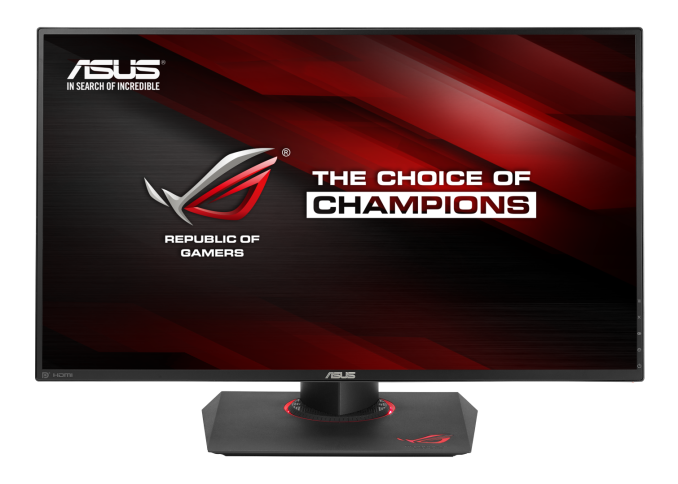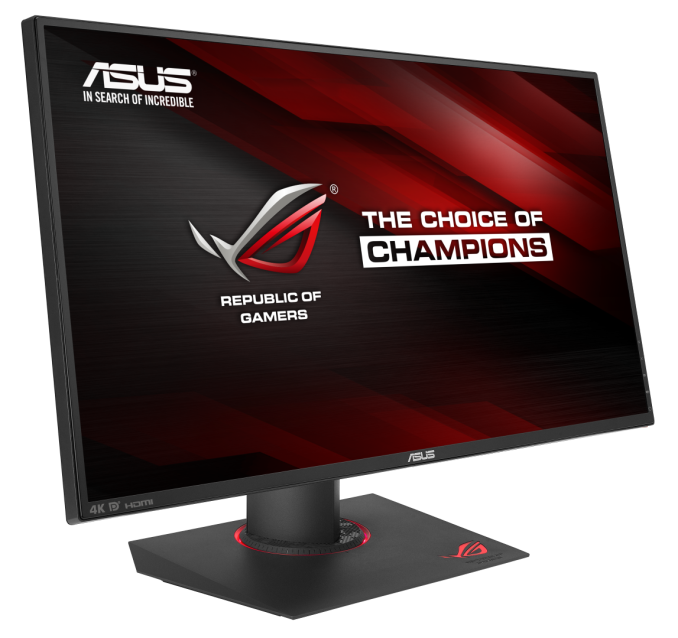ASUS Announces ROG PG279Q & PG27AQ Gaming Monitors
by Brandon Chester on October 9, 2015 6:00 PM EST
Today ASUS announced two new gaming monitors at their Republic of Gamers Unleashed event in San Francisco. Both displays are 27" IPS panels, although there are some significant differences between the two that make each one appeal more or less for certain genres of games. Below you can find all the relevant specifications for both of ASUS's new monitors.
| ASUS PG279Q | ASUS PG27AQ | |
| Resolution | 2560x1440 | 3840x2160 |
| Panel Size | 27" | |
| Panel Type | WLED + IPS | |
| Refresh Rate | 144Hz (OC 165Hz) | 60Hz |
| Contrast Ratio | 1000:1 | |
| Peak Brightness | 350 nits | 300 nits |
| Response Time (GtG) | 4ms | |
| Viewing Angle (H/V) | 178° / 178° | |
| Inputs and Outputs | DisplayPort 1.2 HDMI 1.4 2x USB 3.0 3.5mm audio |
|
| Color Depth | 16.7 million (8bit) | 1.07 billion (10bit) |
| Speakers | 2x 2W Stereo | |
| Other Features | NVIDIA G-Sync NVIDIA Ultra Low Motion Blur |
NVIDIA G-Sync |
| Price | $799 | N/A |
Starting with the PG279Q, we see that it's a 27" WQHD IPS panel with a refresh rate of 144Hz. This monitor is definitely targeted more toward gamers who play games like first person shooters where a high refresh rate is a greater asset than a higher resolution. When paired with a GTX 960 or faster NVIDIA GPU the display's refresh rate can be boosted up to 165Hz, and ASUS has even included a button on the monitor to switch between the two refresh rates on command. This is actually more useful then it sounds, because a user can easily move to 165Hz while gaming, and stick with 144Hz in typical use which will also eliminate telecine judder in 24fps video content.
As for the PG27AQ, I would imagine that gamers who play RTS and simulation games would choose it over the PG279Q for its higher resolution. It's a 27" UHD panel with a refresh rate of 60Hz, and a greater 10bit color depth than the PG279Q's 8bit color. It shares most of the remaining specifications with the PG279Q, including a contrast ratio of 1000:1, a 4ms grey to grey response time, a 178 degree viewing angle on both axis, and the inputs and outputs listed above.
Both of these new monitors feature NVIDIA's G-Sync adaptive refresh rate technology. Even on the PG27AQ this can be useful despite it only being a 60Hz panel, as it will produce a much more fluid image if a game's frame rate drops below 60fps than a non G-Sync / FreeSync display. However, only the PG279Q has NVIDIA's Ultra Low Motion Blur technology which uses a strobing backlight to reduce motion blur. It's worth noting that G-Sync and ULMB are mutually exclusive and you need to choose which one you want a game to use based on whether or not you can maintain the PG279Q's native refresh rate of 144/165Hz.
The ASUS PG279Q will be available in November, with a starting price of $799 in the United States. Pricing and availability for the PG27AQ is currently unknown, but I would imagine that the price will be in the same realm as the PG279Q.











38 Comments
View All Comments
meacupla - Saturday, October 10, 2015 - link
I don't understand what you are trying to get at. These use IPS panels, so they should have reasonably good horizontal viewing angles at normal viewing distances for a PC monitor.sheh - Monday, October 12, 2015 - link
It's not only about IPS, and IPS aren't all created equal. One prominent difference is in IPS glow. Some panels have none, or almost none. I'm sure also non-black colors behave differently in different panels.If the specs were meaningful (what is it currently, the viewing angles for 1:10 contrast?) we might have more competition as it's easier to compare official specs than it is to hunt for, and extract info from, detailed reviews.
TheCurve - Friday, October 9, 2015 - link
Anandtech: if you're wondering what your audience would like to see, these monitors get my vote!shane007 - Friday, October 9, 2015 - link
Good now they are out the way they can work on what we really want.Here is my wish list for next screen,
28-32inch
4k resolution
IPS
4ms or less response times
And the most important part ABOVE 60hz, preferably 120hz or more.
They need to make next gen cards with display port 1.3 or skip to 1.4a and also implement new display port into the next monitors.
You watch 4k gaming take off once we get beyond 60hz, Don't worry about cards not being powerful enough, There are many out there that already run multiple gpu's and next years 16nm gpu's should easily start getting above 60fps on a single card(depending on game of course).
I am already running some AAA titles at the maximum 60fps the 4k monitor can go to with settings on max with 2x980ti cards.
mobutu - Sunday, October 11, 2015 - link
not quite there but close:http://www.tftcentral.co.uk/reviews/acer_predator_...
Morawka - Friday, October 9, 2015 - link
Imagine in 10 years when we have OLED monitors pushing 600hz with gsync.OLED can refresh so much faster, plus the colors are like 14bit.
mooninite - Saturday, October 10, 2015 - link
I was hoping the 1440 monitor would be cheaper than the Acer that has been out for a while... No luck. :(Maybe the Acer one will go on sale.
B3an - Saturday, October 10, 2015 - link
Not interested in these, but does anyone know what's happening with the ASUS ProArt PA329Q? It was announced many months ago and it's STILL not available.r3loaded - Saturday, October 10, 2015 - link
I'm just waiting now for a DisplayPort 1.3 monitor with a non-TN panel that can do 4K at a refresh rate higher than 60Hz, ideally 120Hz. Adaptive sync would also be extremely beneficial for such a monitor.User.Name - Saturday, October 10, 2015 - link
I wish that NVIDIA would enable ULMB at lower refresh rates. Ideally it would operate at any refresh rate that the monitor can sync to, instead of being limited to 85/100/120Hz.Many games are capped to 60 FPS, so there is a need for ULMB at 60Hz. Older arcade games may even be running at refresh rates lower than 60Hz.
I've dealt with CRTs before and can handle the flicker. Let me make the decision of whether or not 50/60Hz flicker is acceptable.
Only BenQ monitors seem to have the option for a single strobe at any refresh rate that the monitor will sync to - but I'm not sure if that applies to their G-Sync monitors, and none of their gaming monitors seem to have 10-bit IPS panels. (or IPS panels at all)